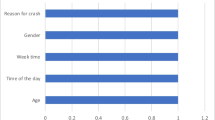Abstract
The motorcycle is considered one of the most applicable transportation modes for various trips in Iran. According to a 2011 report by Iran’s Police Department, motorcyclists and their passengers accounted for almost 25% of all crash fatalities. The objective of this study is to identify the most important factors that contribute to the fault of motorcyclists involved in crashes. The classification and regression trees model is used in this research to differentiate between at-fault and not-at-fault cases. The results show collision type to be the most determining factor for at-fault probability of motorcyclists. According to this fact, the probability of rear-end collision is the highest, while the probability of side collisions is the lowest. Other factors involved vary according to the collision type. Factors affecting rear-end collisions the most are passenger characteristics and the rider’s age. However, side collisions are mainly due to lighting conditions and area types (urban and rural roads). Finally, this paper suggests that training riders and installing warning systems that warn drivers when they are too close to motorcycles can reduce rear-end and side collisions to a great extent.





Similar content being viewed by others
References
Vlahogianni EI, Yannis G, Golias JC (2012) Overview of critical risk factors in Power-Two-Wheeler safety. Accid Anal Prev 49:12–22
Haque MM, Chin HC, Huang H (2009) Modeling fault among motorcyclists involved in crashes. Accid Anal Prev 41(2):327–335
Lardelli-Claret P et al (2005) Driver dependent factors and the risk of causing a collision for two wheeled motor vehicles. Inj Prev 11(4):225–231
Chang HL, Yeh TH (2007) Motorcyclist accident involvement by age, gender, and risky behaviors in Taipei, Taiwan. Transp Res Part F Traffic Psychol Behav 10(2):109–122
Perez-Fuster P et al (2013) Modeling offenses among motorcyclists involved in crashes in Spain. Accid Anal Prev 56(0):95–102
Liu CC, Hosking SG, Lenné MG (2009) Hazard perception abilities of experienced and novice motorcyclists: an interactive simulator experiment. Transp Res Part F Traffic Psychol Behav 12(4):325–334
Rutter DR, Quine L (1996) Age and experience in motorcycling safety. Accid Anal Prev 28(1):15–21
Moskal A, Martin JL, Laumon B (2012) Risk factors for injury accidents among moped and motorcycle riders. Accid Anal Prev 49:5–11
Baldi S, Baer JD, Cook AL (2005) Identifying best practices states in motorcycle rider education and licensing. J Saf Res 36(1):19–32
Schneider Iv WH et al (2012) Examination of factors determining fault in two-vehicle motorcycle crashes. Accid Anal Prev 45:669–676
Wanvik PO (2009) Effects of road lighting: an analysis based on Dutch accident statistics 1987–2006. Accid Anal Prev 41(1):123–128
Haque MM, Chin HC, Debnath AK (2012) An investigation on multi-vehicle motorcycle crashes using log-linear models. Saf Sci 50(2):352–362
Schneider WH, Savolainen PT, Moore DN (2010) Effects of horizontal curvature on single-vehicle motorcycle crashes along rural two-lane highways. Transp Res Rec 2194(1):91–98
Bosurgi G, Bongiorno N, Pellegrino O (2016) A nonlinear model to predict drivers’ track paths along a curve. Int J Civil Eng 14(5):1–10
Luque R, Castro M (2016) Highway Geometric design consistency: speed models and local or global assessment. Int J Civil Eng 14(6):1–9
Kashani AT, Rabieyan R, Besharati MM (2014) A data mining approach to investigate the factors influencing the crash severity of motorcycle pillion passengers. J Saf Res 51:93–98
Breiman L (1998) Classification and regression trees. Chapman & Hall, Boca Raton
de Oña J, López G, Abellán J (2013) Extracting decision rules from police accident reports through decision trees. Accid Anal Prev 50(0):1151–1160
Pande A, Abdel-Aty M (2009) Market basket analysis of crash data from large jurisdictions and its potential as a decision support tool. Saf Sci 47(1):145–154
Montella A et al (2012) Analysis of powered two-wheeler crashes in Italy by classification trees and rules discovery. Accid Anal Prev 49:58–72
Jiang X (2005) An investigation of the underlying assumptions of quasi-induced exposure. Michigan State University. Department of Civil and Environmental Engineering
Kashani AT, Mohaymany AS (2011) Analysis of the traffic injury severity on two-lane, two-way rural roads based on classification tree models. Saf Sci 49(10):1314–1320
Hing, JYC, Stamatiadis NL (2003) Aultman-Hall, Evaluating the impact of passengers on the safety of older drivers. J Saf Res 34(4):343–351
Engström I et al (2008) Young drivers—Reduced crash risk with passengers in the vehicle. Accid Anal Prev 40(1):341–348
Braitman KA, Chaudhary NK, McCartt AT (2011) Effect of passenger presence on older drivers’ risk of fatal crash involvement, I.I.H. Safety (ed) p 16
Li M-D et al (2009) Survival hazards of road environment factors between motor-vehicles and motorcycles. Accid Anal Prev 41(5):938–947
Author information
Authors and Affiliations
Corresponding author
Rights and permissions
About this article
Cite this article
Anvari, M.B., Tavakoli Kashani, A. & Rabieyan, R. Identifying the Most Important Factors in the At-Fault Probability of Motorcyclists by Data Mining, Based on Classification Tree Models. Int J Civ Eng 15, 653–662 (2017). https://doi.org/10.1007/s40999-017-0180-0
Received:
Revised:
Accepted:
Published:
Issue Date:
DOI: https://doi.org/10.1007/s40999-017-0180-0




